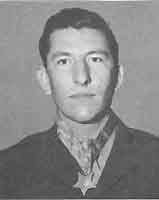Return to Naval Historical
Center home page.  Return to Online
Library Listing
Return to Online
Library Listing

DEPARTMENT OF THE NAVY -- NAVAL HISTORICAL CENTER
805 KIDDER BREESE SE -- WASHINGTON NAVY YARD
WASHINGTON DC 20374-5060

Online Library of Selected Images:
-- PEOPLE -- UNITED STATES --
Sergeant William G. Harrell, USMC, (1922-1964)
William George Harrell was born on 26 June 1922 in Rio Grande
City, Texas. After graduating from high school in 1939, he worked
as a pipefitter and attended the Agricultural and Mechanical College
of Texas. In July 1942, Harrell enlisted in the U.S. Marines and
completed basic training at the Marine Corps Recruit Depot, San
Diego, California. He then served in the Depot's 1st Guard Company.
Upon transferring to Headquarters and Service Company, 2nd Battalion,
at Camp Elliott in San Diego, he was promoted to Corporal. In
February 1943, Corporal Harrell went overseas with Company A,
1st Battalion, Twenty-eighth Marines, Fifth Marine Division. After
being promoted to Sergeant, he participated in the assault on
Saipan in June and July of 1944.
Sergeant Harrell next took part in the Iwo Jima campaign in
February and March 1945 as an assault group leader. At dawn on
3 March 1945, he repulsed an intense enemy assault on his position,
fighting on despite serious injuries, including the loss of both
hands to grenades. For his "conspicuous gallantry and intrepidity"
and "indomitable fighting spirit against almost insurmountable
odds," he awarded the Medal
of Honor, which was presented by President Harry S. Truman
at the White House on 5 October 1945. William G. Harrell died
on 9 August 1964 and is buried at Fort Sam Houston National Cemetery,
San Antonio, Texas.
This page features the only image we have concerning William
G. Harrell.
Click on the small photograph to prompt
a larger view of the same image.
Photo #: NH 103821
Sergeant William G. Harrell, USMC
Halftone reproduction of a photograph, copied from the official
publication "Medal of Honor, 1861-1949, The Navy",
page 202.
William G. Harrell received the Medal of Honor for "conspicuous
gallantry and intrepidity at the risk of his own life" on
3 March 1945, during the Battle of Iwo Jima.
U.S. Naval Historical Center Photograph.
Online Image: 47KB; 590 x 765 pixels |
 |
Medal of Honor citation of Sergeant William G. Harrell, USMC
(as printed in the official publication "Medal of Honor,
1861-1949, The Navy", page 202):
"For conspicious gallantry and intrepidity at the risk
of his life above and beyond the call of duty as Leader of an
Assault Group, attached to the First Battalion, Twenty-eighth
Marines, FIFTH Marine Division, during hand-to-hand combat with
enemy Japanese at Iwo Jima, Volcano Islands, on 3 March 1945.
Standing watch alternately with another Marine in a terrain studded
with caves and ravines, Sergeant Harrell was holding a position
in a perimeter defense around the company command post when Japanese
troops infiltrated our lines in the early hours of dawn. Awakened
by the sudden attack, he quickly opened fire with his carbine
and killed two of the enemy as they emerged from a ravine in
the light of a star-shellburst. Unmindful of his danger as hostile
grenades fell closer, he waged a fierce lone battle until an
exploding missile tore off his left hand and fractured his thigh.
He was vainly attempting to reload the carbine when his companion
returned from the command post with another weapon. Wounded again
by a Japanese who rushed the foxhole wielding a saber in the
darkness, Sergeant Harrell succeeded in drawing his pistol and
killing his opponent and then ordered his wounded companion to
a place of safety. Exhausted by profuse bleeding but still unbeaten,
he fearlessly met the challenge of two more enemy troops who
charged his position and placed a grenade near his head. Killing
one man with his pistol, he grasped the sputtering grenade with
his good right hand and, pushing it painfully toward the crouching
soldier, saw his remaining assailant destroyed but his own hand
severed in the explosion. At dawn Sergeant Harrell was evacuated
from a position hedged by the bodies of 12 dead Japanese, at
least 5 of whom he had personally destroyed in his self-sacrificing
defense of the command post. His grim fortitude, exceptional
valor and indomitable fighting spirit against almost insurmountable
odds reflect the highest credit upon himself and enhance the
finest traditions of the United States Naval Service." |
 Return to Naval
Historical Center home page.
Return to Naval
Historical Center home page.
Page made 1 June 2006
